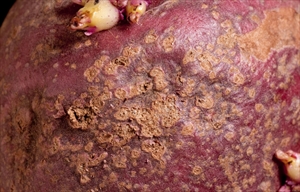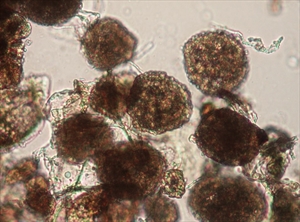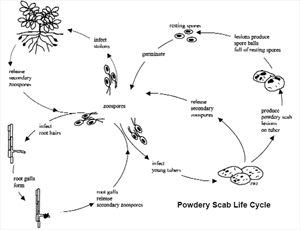Powdery scab
Pacific Pests, Pathogens, Weeds & Pesticides - Online edition
Pacific Pests, Pathogens, Weeds & Pesticides
Potato powdery scab (294)
Spongospora subterranea f.sp. subterranea. It is a member of the family Plasmodiophoraceae, the same family as that of Plasmodiophora brassicae, the cause of club root of brassicas (see Fact Sheet no. 283). Like Plasmodiophora brassicae, powdery scab belongs to a group called rhizaria in the Kingdom Protista; they are related to slime moulds.
Asia, Africa, North, South and Central America, Europe, Oceania. It is recorded from Australia, New Zealand, and Papua New Guinea.
The main host is potato, but other hosts have been recorded, e.g., tomato (galls on the roots), capsicum, ulluco, and weeds in the potato family (Solanaceae), e.g., jimson weed, cape gooseberry, black nightshade.
The damage is done by an organism that is neither animal, plant or fungi, but is one-celled with organelles that have membranes around them, especially the nucleus.
Symptoms begin with small purple spots on the skin of the tubers, like small pimples and, later, these become raised, wart-like and powdery, roughly circular up to 10 mm, but often join together and become much larger (Photos 1&2). These are the 'scabs', which contain resting spores. The resting spores occur as brown sporeballs, known as 'sporosori' (Photo 3).
Apart from infecting tubers, roots can also be infected resulting in small (1-10 mm) whitish galls, turning darker as they mature.
Symptoms can be mistaken for those of common scab (see Fact Sheet no. 293), but the development of spores in sporosori sets them apart.
The life-cycle is complex and not well known (Diagram). The resting spores in soil germinate in the presence of potato plants, and produce swimming zoospores which penetrate the root hairs, the underground stems called 'stolons', as well as the tubers through the lenticels. Galls appear on the roots within 3 weeks. More zoospores are released and these secondary zoospores cause further infections. Most tuber infections occur at this time, resulting in powdery scab lesions and sporeballs, with their thick-walled resting spores.
Spread of powdery scab over short distances is on soil on machinery and shoes, and also by livestock if they have eaten infected tubers and are allowed to roam in uninfected fields. Similarly, farmers may use livestock manure to improve soil nutrition and unwittingly spread the spores. Long distance spread is on infected tubers. Survival is in tubers and by resting spores which can survive for up to 10 years in soil.
The impact of this disease is like that of common scab. The impact is not because it lowers yield, it is because the tubers are unsightly and unmarketable either for eating or for seed. If they are sold for processing, the price is often reduced because more flesh has to be removed due to powdery scab infection.
Tuber with cavities caused by powdery scab are more susceptible to rots that occur in soil and in storage, caused by Phytophthora erythrseptica (pink rot), Phytophthora infestans (late blight), and Fusarium dry rot.
Spongospora subterranea is also important as it spreads Potato mop top virus that causes brown curved lines of rot in the flesh of tubers. It is a serious disease.
Look for powdery spots on the tuber and scrape some of the contents onto a microscope slide and look for the spores and spore balls at 10x magnification. There are also molecular and antibody methods for detecting the spores from the soil.
CULTURAL CONTROL
Before planting:
- Improve drainage by planting potatoes on hills or raised beds. Powdery scab is worse under wet conditions because it has swimming spores that need water for spread and infection.
- Use only disease-free tubers, if possible seed that is certified by government agencies.
- Avoid planting where the disease is known to occur.
During growth:
- Do not use manure from animals that have been fed diseased potatoes, otherwise the spores will be spread to the fields; or if the manure is to be used, make sure that it is well-composted.
- Do not provide excessive amounts of nitrogen fertilizer as it increases the amount of root growth for infection.
After harvest:
- Use crop rotations of 3 years, ideally longer.
RESISTANT VARIETIES
Russet (reddish-brown) varieties are said to be more resistance than those with smooth red or white skin. Check with local retailers if they are available in your country.
CHEMICAL CONTROL
There is no effective chemical for the control of this disease, although mancozeb treatment of the seed may be useful to reduce the amount of spores.
____________________
When using a pesticide, always wear protective clothing and follow the instructions on the product label, such as dosage, timing of application, and pre-harvest interval. Recommendations will vary with the crop and system of cultivation. Expert advice on the most appropriate pesticide to use should always be sought from local agricultural authorities.
AUTHOR Grahame Jackson
Information from Diseases of vegetable crops in Australia (2010). Editors, Denis Persley, et al. CSIRO Publishing; and from Powdery scab (2016) Wikipedia. (https://en.wikipedia.org/wiki/Powdery_scab). Photos 1-3 Sandra Jensen, Cornell University, Bugwood.org. Diagram Steven B Johnson (2002) Bulletin No. 2436, Powdery Scab of Potatoes. The University of Maine. (https://extension.umaine.edu/publications/2436e/).
Produced with support from the Australian Centre for International Agricultural Research under project PC/2010/090: Strengthening integrated crop management research in the Pacific Islands in support of sustainable intensification of high-value crop production, implemented by the University of Queensland and the Secretariat of the Pacific Community.







